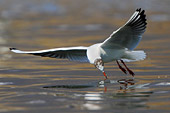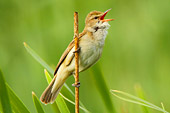Nature has always fascinated me a lot, but mountains in particular have had a strong influence on me. Their majestic presence fills the space with energy that overwhelms body and spirit. This feeling is almost euphoric in the spring, when trees are in bloom and forest birds sing their songs that echo far away.
Ever since I took up photography, walks in nature have become even more exciting because of the ability to take photos of birds and animals. Forest birds are secretive and very beautiful, and their melodic songs make them even more magical.
There isn’t a bird I don’t like, but still from all the birds I have seen, those that excite me the most are the various kinds of owls. The reason is the fact that most of them lead a secretive life and it is very difficult to observe them, let alone take photos of them. Their presence in the woods, among the old trees and the atmosphere there itself, make them look like forest spirits bearing the knowledge and the insight of the whole nature. If you can look into their eyes you could see the infinity of the universe.
I remember the first time I heard the muffled singing of a pygmy-owl – my heart almost stopped from excitement and emotion. It looks so delicate and fragile, but it fully dominates the forest.

Translated by Maya Golemanova
Unfortunately, the destruction of the forests and the habitats of such birds make it even more difficult to see these symbols of the sacred nature, and what are the forests and nature without their occupants?
Deforestation in protected areas and national parks for the purpose of construction, ski slopes and similar unreasonable things is a real threat to endemic species such as the pygmy-owl, which may completely disappear as species in Bulgaria, along with the few remaining signs of humanity and concern for nature, which we are left with.
General information about Owls
Owls can be found in different parts of Earth – except in Antarctica and on some islands. There are all in all about 133 types, 10 of which are spread in Bulgaria. The most common are the Long-eared Owl, the ordinary Owl and Tawny Owl.
Their silent flight, the ability to see in the dark, the acute hearing and the ability to react instantaneously justified the reason to be called winged cats in the past. The whole body of the owls is adapted to nightlife. Their large eyes in the front part of the head allow them to see at any time of the day.
Owls have very acute hearing. Only a very slight noise made by the prey is enough to be detected and caught, even in the impenetrable darkness. The flexible neck allows the owls to rotate its head up to 270 degrees in both sides, and 180 degrees horizontally. Thus they have visibility all around them.
The small kinds of owls live up to 20 years, and the large ones reach the age of 68 years.
Pygmy Owl / Glaucidium passerinum
The Pygmy-owl is among the smallest owls – the weight of larger females reaches only 75 g. The wings are short and roundish, and the head is round. The eyebrows look big and bright. The brownish plumage is not very attractive. The stomach and the back are slightly lighter.
The pygmy-owl is the rarest kind in Bulgaria. It inhabits old large spruce forests – those in the north are more preferable and they should be high in the mountains – to 1500 m.
It searches for food and sings mainly in the evening and morning, but it very often does this during the day. It is active mainly in the dark but also during the day. It lurks and hunts in total darkness. In Bulgaria, its spring activity begins in March and lasts until mid-May. In the autumn it sings in September and October. Song of these species can be heard up to about 800 m.
Its ancestors occupied only small areas in Bulgaria, and until a few years ago it was believed to have completely disappeared and are now in Bulgaria’s Red Book of Protected Species. This rare kind of owls is protected by the Biodiversity Act.
A Pygmy-owl nests in old woodpecker holes – mainly in those of the Great Spotted Woodpecker. Throughout the year, it reveals its presence through a distinctive call sound similar to monotonous hissing. Its main preys are small rodents and songbirds – mice, shrews, gold crests, tits, and others. This tiny owl has the “habit” of storing large quantities of food for winter in makeshift “stores” where up to 1000 small animals can be found.
For ornithologists the tiny owl is also known for its curiosity and incautiousness. If you accidentally run into it in the forest it won’t take off in panic but it will continue to examine you in curiosity behind the branches of the tree.
Only a few people (including me) have been lucky enough to see the tiny owl from a short distance and feel its noble presence. The pygmy-owl is also extremely gentle with its partner. Couples are formed in autumn. During the mating period its song is very melodic. The entire repertoire varies in melodic sounds, and lasts for an hour and ends with specific melodious trills.
The pygmy owl lays snow-white eggs, usually in April, and incubates them diligently, leaving the nest only in immediate danger. The number of eggs varies between 4 and 7 depending on the abundance of food. The eggs hatch asynchronously. The little ones stay with the adults and learn from them until early autumn.
After the little ones hatch, the female cleans carefully the remains of the shells and the food in the nest, built up during the incubation. The place of disposal is near the trunk of the tree hollow. It is namely because of these remains that a secret nest can be found.









June 6th, 2011 00:13
Hi Nikolay,
I’ve just surfed through your new website and I really like it! Much better than the old one and of course your photos are top!
Regards
Dries
Belgium
June 6th, 2011 01:17
Hi Dries,
Thank you for your comment. I really put a lot into this project and hope to have time in the future for articles and daily photos. I am happy that you like the site and the images and hope you enjoy the future ones :)
Are you wildlife photographer?
Regards
Niki
June 24th, 2011 16:27
Страхотен сайт, поздравления.
June 26th, 2011 21:39
Hi
I found you name via wild wonders of europe and you nice image of the lovely Pygmy owl. Nice article and very nice movie clips. I will definitely visit your website here after. I am also an owl freak :)
BR
Henrik
June 27th, 2011 09:23
Здрасти Илияне,
Радвам се че ти харесва. С много желание и старание го правихме с дизайнера :)
June 27th, 2011 09:27
Hi Henrik,
Yes, I particularly love owls :)
Unfortunately, it is quite difficult to take photos of most of them here in my country. Some other european countries are paradise for owl photographers and I hope to manage to go to a photo trip for owls within the forthcoming years.
I am updating my site daily with photos and several articles in a month, so its worth visiting it again ;)
What about you, do you have a website?
June 27th, 2011 16:21
Hi
We have 9(11) owls here in sweden! pygmy, tengmalm, ural, great grey, short eared, long eared, tawny, hawk and eagle owl and I guess there are some snowy owls and maybe some Barn owls. I have seen all except snowy and barn owl but I don´t have images of all :(.
My website http://www.henrikranden.com
BR
Henrik
June 27th, 2011 16:49
Ohh, Henrik, the ural and great grey owls I love the most.
your owl series are very good, the squirrel series is also very funny :)
I saw you are shooting with Nikon. I recently got the D3 and 200-400/4 and its a terrific combination – I will use both systems for now – the Nikon will be for the action/flight shots. Which version of 300/2.8 do you own? A friend of mine have done amazing photos with the old version of this lens – the VR1.
June 28th, 2011 23:12
Hi
I have sent you a mail.
BR
Henrik
September 1st, 2011 19:42
Привет Николай първо искам да те поздравя за хубавия сайт и да ти пожелая много бъдещи успехи. Знам, че си зает човек, но ще се радвам за в бъдеще да публикуваш повече статии с включени в тях практически съвети за начинаещите (например описание на това как обикновенно протича един твои снимачен ден сред дивата природа, как избираш място за снимане …….). Ти си човек от когото има много какво да научим.
April 11th, 2013 15:50
Здравей,
Страхотен сайт и отлични снимки, адмирации за което.
Относно врабчовата кукумявка – в борисовата градина вечер (много рядко сутрин) се чува много подобно “монотонно подсвирване”, винаги се чудех, до вчера – совоподобна страхотна душица. За съжаление бях само с телефон и макар да я осветих с фар, за да я видя не сеполучи снимка. Много ще ми е интересно да споделиш дали би могла да е от същия вид.
Успех за напред! Дано повече хора като теб!
Поздрави,
Димо
April 20th, 2013 10:49
Здрасти Димо,
Благодаря за отзива. Колкото до кукумявката в парка, най-вероятно е бил или чухал, или горска ушата сова. Врябчовите кукумявки живеят над 1500м надмосрска височина, обикновено обитават северните склонове на планините. Ако имаш нужда от информация за определяне на даден вид, не се колебай пак да пишеш :) Дори да не мога да определя вида, има профи орнитолози, които ще го направят.
Поздрави,
Ники
February 18th, 2017 20:24
Здравейте,изчетох с внимание написаното за кукумявките от вас.Колкото и смешно и странно да ви звучи около нас има кукумявка , която не мога да оприлича каква е но я чувам постоянно и естествено се страхувам, защото знам поверието за нея. Бихте ли ми помогнали да си отговоря на много въпроси около нея,да не се тормозя и притеснявам със суеверия? Ще се радвам да ми пишете на имейла , там ще задам въпросите да не ми се смеят тук хората , които ви четат.Благодаря ви , ще чакам помоща ви , която е много важна за мен и семейството ми